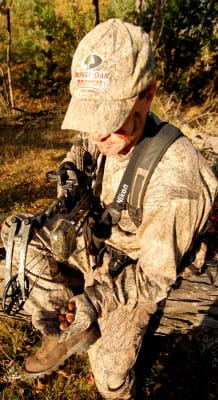Submitted By:
Mike Hanback – USA Guest Author

Forget the rut, for now.
Early archery season is right around the corner, and it’s a great time to shoot a whopper whitetail. Dang near as good as the rut! Bucks have two weaknesses. Singles, doubles and bachelor groups – generally a couple of small guys hanging out with an old, big-racked shooter or two – are visible in fields where you can glass them. Moreover, the deer are still locked into predictable summer bed-to-feed patterns. We’ve highlighted five of the best early season hunting methods.
Try these early-bird tactics, but be warned. You might have to stop hunting long before the November rut because your tags might be filled.
Take a Field Post
“Hang a tree stand on the edge of a crop or clover field where you’ve glassed some bucks, or even in the middle of the field,” says Luke Strommen, who guides bowhunters on the famous Milk River in Montana. “People haven’t hassled bucks for 8 or 9 months, and they’re pretty lax. If you’re smart with the wind, you can sneak in tight where they feed in the afternoons, and they’ll linger in the fields in the mornings, too.”
One September four of Strommen’s clients arrowed four bucks out of the same lock-on in a cottonwood tree in the middle of 200 acres of alfalfa. In early October, Luke shot a fifth buck, “Massy,” from the same tree one morning. Pretty cool, huh?
Hunt a Water Hole
Scout for clean water 100 yards or so back in the woods from a field where deer feed. A river or creek pool, a clear, oxygenated pond… you get the idea. The hotter it is, the more deer have to drink. Sneak to a water hole from downwind and set a stand quietly because some deer are likely bedded close by in the cover. A buck might stop in for a sip before or after eating in the morning or evening, so it’s a double-duty post.
Go Nuts
You can never, I repeat never, go wrong by locating a stand near the first white-oak acorns that fall 50 to 100 yards from a corn field or food plot. Many does and bucks will stage and gnaw acorns before heading out into the field in late afternoon. Set up downwind of the mast and near a trail that leads to it. Fresh rubs on the trail are hot sign.
Cool Down
The two or three days after the first cold front of the season blows through and drops the temperature from, say, 80 degrees to 50, are the best days. Bucks sluggish in the heat get spunky and start moving and rubbing more. Head to your best stand near crops or acorns and be ready for action.

Get Your Grunt On?
Taylor Fitzpatrick bowhunted in Montana the first week of September. The 19-year-old spotted a buck and grunted at him.
“He looked up and walked to me on a string, and I shot him,” Taylor says.
No doubt that was the first buck grunted up and killed in America that season.
A young, energetic hunter like Taylor is not afraid to try different things, like grunting to a buck in September. That is something many of us seasoned veterans might not do because we “know” grunting works best later on in the rut.
Well, change your thinking. I have. I carry my grunter from day one of archery season, and you should too. If you spot a big deer out of range in a field or slipping through the trees, might as well grunt at him. What’s to lose? I do advise softer, steadier calls rather than the loud, guttural grunts that work best later in the rut.
Who knows, you might call in and shoot a 10-pointer before most of your buddies even start hunting. Good luck!
Check out Hanback’s Big Deer Blog (mikehanback.com).







